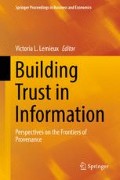Abstract
During the 1960s Peter J Scott and colleagues at the then Commonwealth Archives Office (now National Archives of Australia) devised a new approach to archival intellectual control, which separated descriptive information about the creators of records from information about the records themselves. This paper provides an overview of the major features of Scott’s system, placing it in its historical context and exploring its impact on the development of international archival descriptive standards.
Access this chapter
Tax calculation will be finalised at checkout
Purchases are for personal use only
Notes
- 1.
The Society of American Archivists online glossary defines ‘record group’ as: a hierarchical division that is sometimes equivalent to provenance, representing all the records of an agency and its subordinate divisions. However, the records of a large agency may be broken into several record groups, treating the records of different divisions as separate collections rather than as a series. http://www2.archivists.org/glossary/terms/r/record-group.
- 2.
Source for Fig. 1: ‘Conceptual and Relationship Models: Records in Business and Socio-legal Contexts’, a deliverable from the 1998–1999 Australian Research Council funded Monash University research project, called ‘Recordkeeping Metadata Standards for Managing and Accessing Information Resources in Networked Environments over time for Government. Commerce, Social and Cultural Purposes’, Chief Investigators Sue McKemmish, Ann Pedersen and Steve Stuckey.http://www.sims.monash.edu.au/research/rcrg/research/spirt/deliver/conrelmod.html; model developed by Sue McKemmish, Glenda Acland, Kate Cumming, Barbara Reed, and Nigel Ward. The Australian RKMS was a deliverable from the 1998–1999 Australian Research Council funded Monash University research project, called ‘Recordkeeping Metadata Standards for Managing and Accessing Information Resources in Networked Environments over time for Government. Commerce, Social and Cultural Purposes’, Chief Investigators Sue McKemmish, Ann Pedersen and Steve Stuckey. McKemmish, S., Acland, G., Ward, N., Reed, B.: Describing Records in Context in the Continuum: The Australian Recordkeeping Metadata Schema. Archivaria 48, 3–43 (1999).
- 3.
This work is currently being progressed by the International Council on Archives Expert Group on Archival Description, see http://www.ica.org/en/about-egad
References
International Standards Organization: ISO 15489.1 Records Management Part 1: General. ISO, Geneva (2001)
International Council on Archives: ISAAR (CPF) International Standard Archival Authority Record for Corporate Bodies, Persons and Families, 2nd edn. ICA, Paris (2004)
Muller, S., Feith, J.A., Fruin, R.: Manual for the Arrangement and Description of Archives: Drawn up by the direction of the Netherlands Association of Archivists. Leavitt, A.H.: English translation of the 2nd edn. Society of American Archivists, Chicago (2003)
Hurley, C.: Problems with provenance. Arch. Manuscr.: J. Aust. Soc. Arch. 23(2), 234–259 (1995)
Scott, P.: The record group concept: a case for abandonment. Am. Arch. 29, 493–504 (1966)
Wagland, M., Kelly, R.: The series system – a revolution in archival control. In: McKemmish, S., Piggott, M. (eds.) The Records Continuum: Ian Maclean and Australian Archives First Fifty Years, pp. 131–149. Ancora Press, Melbourne (1994)
Hurley, C.: The Australian (‘Series’) System: an exposition. In: McKemmish, S., Piggott, M. (eds.) The Records Continuum: Ian Maclean and Australian Archives First Fifty Years, pp. 150–172. Ancora Press, Melbourne (1994)
Reed, B.: Metadata: core record or core business? Arch. Manuscr. 25(2), 218–241 (1997)
Cook, T.: What is past is prologue: a history of archival ideas since 1898, and the future paradigm shift. Archivaria 43, 17–63 (1997)
Bearman, D.: Archival Methods. Archives and Museum Informatics, Pittsburgh (1989)
Hurley, C.: What, if anything, is a function? Arch. Manuscr. 21(2), 208–220 (1993)
Hurley, C.: Ambient functions: abandoned children to zoos. Archivaria 40, 21–39 (1995)
Cook, M., Grant, K., Starkey, P.: A Manual of Archival Description. Society of Archivists, London (1985)
Canadian Committee on Archival Description: Rules for Archival Description. Bureau of Canadian Archivists, Ottawa (1990)
Hensen, S.L.: Archives, Personal Papers and Manuscripts. Library of Congress, Washington, DC (1983)
International Council on Archives: International Standard Archival Description (General). ICA, Paris (1994)
Canadian Committee on Archival Description: Rules for Archival Description, 2nd edn. Bureau of Canadian Archivists, Ottawa (2008)
Society of American Archivists: Describing Archives: A Content Standard. SAA, Chicago (2004)
International Council on Archives: International Standard for Describing Functions. ICA, Paris (2011)
Australian Society of Archivists: Describing Archives in Context: A Guide to Australasian Practice. ASA, Canberra (2007)
Author information
Authors and Affiliations
Corresponding author
Editor information
Editors and Affiliations
Rights and permissions
Copyright information
© 2016 Springer International Publishing Switzerland
About this paper
Cite this paper
Cunningham, A. (2016). Describing Archives in Context: Peter J Scott and the Australian ‘Series’ System. In: Lemieux, V. (eds) Building Trust in Information. Springer Proceedings in Business and Economics. Springer, Cham. https://doi.org/10.1007/978-3-319-40226-0_2
Download citation
DOI: https://doi.org/10.1007/978-3-319-40226-0_2
Published:
Publisher Name: Springer, Cham
Print ISBN: 978-3-319-40225-3
Online ISBN: 978-3-319-40226-0
eBook Packages: Economics and FinanceEconomics and Finance (R0)

